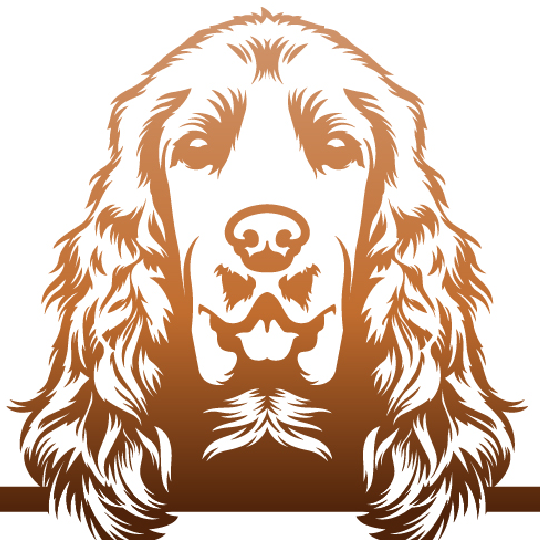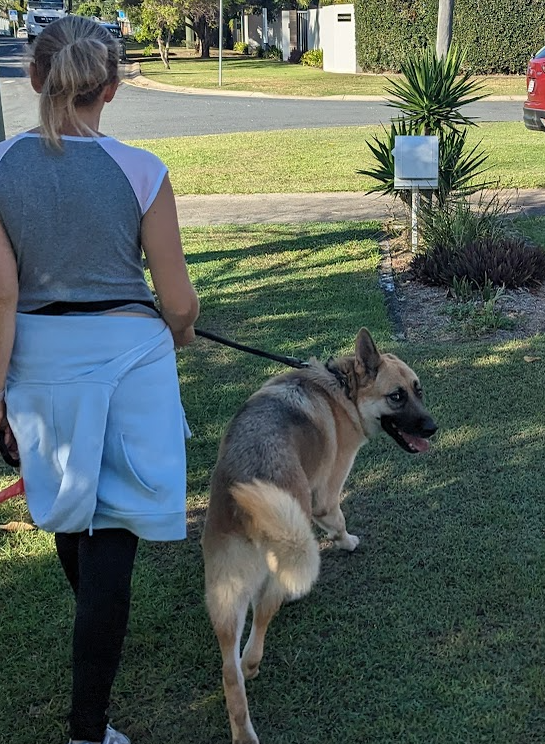HI, Its Mel here, As a seasoned owner of “All For Furry Friends,” a reputable dog walking service on the Gold Coast, I’ve become an expert in navigating the challenges of dog walking safety. Walking a dog that’s packing more strength than its handler requires more than just a sturdy leash; it requires technique, patience, and the proper gear.
Controlling powerful dogs is not just about asserting dominance but about understanding and working with your canine companion in a way that respects both its nature and your safety. Through consistent training and utilizing appropriate dog walking techniques, an enjoyable and safe experience for both of you is absolutely achievable.
Consider walking your dog akin to a dance. Both you and your four-legged partner need to move in sync, and when one of you is significantly stronger, the dance requires more finesse. It’s essential to strike the balance between control and trust, and I’m here to share insights on achieving just that. Whether your companion is a majestic mastiff or a robust retriever, these tips will help you lead with confidence.
Key Takeaways
- Mastery of loose-leash walking is crucial for handling stronger dogs.
- Choosing the right gear can greatly enhance control and safety during walks.
- Consistent training helps prevent injuries that can be caused by pulling.
- Understanding and meeting your dog’s needs is instrumental in managing their energy and strength.
- A front-clip harness is a recommended tool for redirecting a strong dog’s momentum.
- Positive reinforcement and patience play key roles in training your dog for peaceful walks.
Understanding Your Dog’s Strength and Behavior
As an owner of a large and spirited canine, I understand firsthand the tug-of-war that walking such a mighty animal can sometimes feel like. In managing strong dogs during our walks, it’s not only about the physical restraint but also about understanding why they exhibit certain behaviors. From the enthusiastic pull as a squirrel darts by to the assertive stance at the approach of another dog, these actions are communications from our four-legged companions. Walking large dogs means getting to the root of these behaviors, which begins with delving into why they pull on the leash and how to recognize what their body language is conveying.
Why Dogs Pull on the Leash
Any seasoned dog walker will tell you, the world is an exciting place full of smells and sights that beg to be explored, especially from a dog’s perspective. Yet, this natural curiosity is amplified in stronger dogs who may feel the impulse to chase or investigate with vigor due to their inherent power. Therefore, walking large dogs often involves an understanding that pulling isn’t just a nuisance; it’s a manifestation of their exploratory instincts.
A pull on the leash can indicate enthusiasm, a keen interest in the environment, or even an attempt to assert autonomy. As such, managing the eagerness of strong dogs requires a blend of physical control measures and psychological strategies. It’s about guiding their strength and desires in a way that allows for a walk that’s pleasant for both of us.
Recognizing Your Dog’s Body Language
When it comes to walking large dogs, it’s crucial to consider their non-verbal cues. A tense posture might signal alertness to something enticing ahead, while a wagging tail combined with a pull can reflect sheer joy. The subtle differences in their demeanor can drastically change the way I interpret their needs and respond accordingly. It’s not just about managing strong dogs; it’s about responding to their communication, creating a mutual understanding that leads to harmonious walks.
Through my daily interactions and the experiences shared with my clients at “All For Furry Friends,” I’ve discovered that once we begin to see the world from their point of perspective, we become better equipped to manage their actions on our strolls. So, in my ongoing journey to ensure that both the dogs and their owners have enjoyable, safe walks, tuning into the canine’s body language has become a cornerstone of walking large dogs effectively.
Preparation: The Key to Successful Dog Walking
Embarking on a walk with my powerful furry clients has taught me that every successful venture begins with thorough preparation. Owning to my professional dog walking technique, I have honed the process of priming both myself and any controlling powerful dogs for a smooth, incident-free journey. This preparation goes beyond just a mental readiness; it involves a physical and gear-related checklist that ensures both the handler and the dog are equipped to manage the road ahead.
Meeting Your Dog’s Physical Exercise Needs
Ensuring that a dog has been adequately exercised is paramount to a more manageable walking experience, especially when the dog brims with energy. A well-exerted dog, having spent appropriate time playing or running in a yard, is less likely to pull excessively on the leash out of pent-up energy. I like to incorporate a blend of physical activities that not only tire them out but also mentally stimulate them, reducing their desire to chase after every passing distraction.
Choosing the Right Gear Before You Start

Next, I turn my attention to selecting the correct gear. When controlling powerful dogs, the right leash and harness can make all the difference. Leashes should be robust, of sufficient width to handle the pull, and long enough to allow some freedom without compromising on control. Harnesses need to be snug yet comfortable, designed to distribute pressure evenly without restricting movement, and should cater to the dog’s propensity to lead from the front.
Given the variety of available options, I focus on gear that has been tried and tested in the field, gearing up with products that are celebrated for their durability and comfort. Each piece of equipment is meticulously chosen to match the strength and particular needs of my canine clients, all to ensure the safety and enjoyment of our walking adventure.
Selecting the Right Harness for Your Strong Dog
When it comes to dog walking safety, being the owner of a strong canine means facing unique challenges. One of the most effective tools in my arsenal for maintaining control and safety is the right harness for walking a strong dog. My experiences with different breeds and individual temperaments have taught me that harnesses play a critical role in managing our walks. Let’s delve into the key factors to consider when choosing the ideal harness for your robust furry friend.
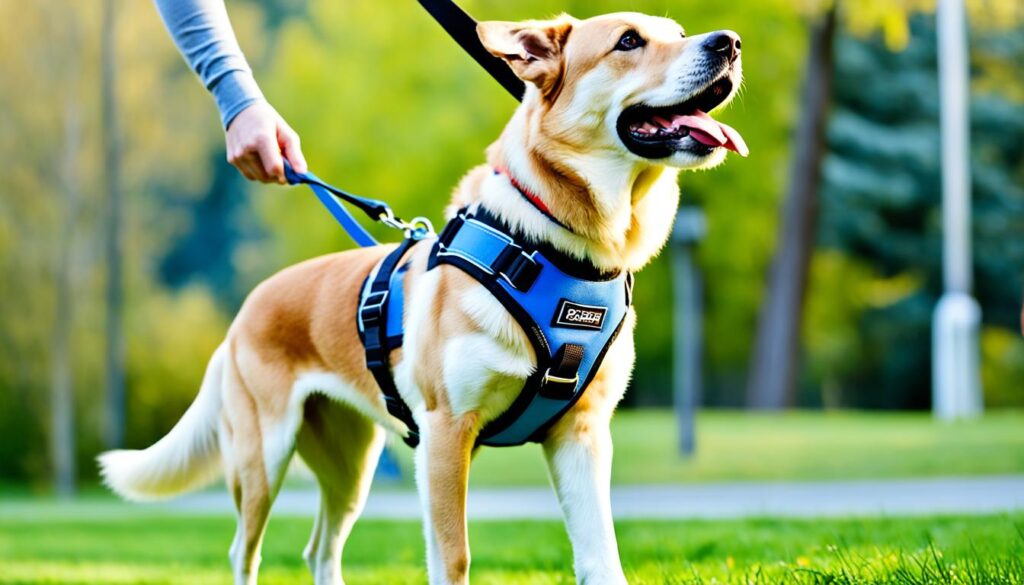
A well-selected harness can be a game-changer in preventing your powerful pooch from pulling you down the street. The front-clip harness, specifically, is my go-to recommendation. It’s ingeniously designed to redirect your dog’s momentum towards you and away from the distraction ahead, preserving your balance and making the walk more enjoyable for both of you.
Selecting a harness that fits comfortably is also paramount. You want the harness to allow free range of motion without the risk of your dog slipping out mid-walk. I’ve lined up a comparison of harness features that I’ve found to be most effective in enhancing dog walking safety:
| Feature | Benefits | Considerations |
|---|---|---|
| Front-clip D-ring | Redirects pulling and asserts control | Ensure the clip is positioned to prevent tangling |
| Snug Fit | Provides security without escape | Adjustability for growth and comfort |
| Padded Chest Plate | Reduces strain during pulling | Must allow for unimpeded shoulder movement |
| Reflective Strips | Enhances visibility for evening walks | Choose a harness with durable, weatherproof materials |
Having used a variety of harnesses, these features collectively contribute to an effective solution for walking bigger dogs. It’s vital to remember that, while gear is essential, it should be complemented with proper training techniques for best results. Combine a top-notch harness with consistent loose-leash training practices, and you’ll be well on your way to more secure and stress-free adventures with your four-legged powerhouse.
The Importance of Consistent Training and Patience
Throughout my experience with “All For Furry Friends,” I have witnessed how consistent training and unwavering patience are the bedrock of learning how to walk a dog that is stronger than you. Tapping into the power of positive reinforcement, I’ve shaped many a canine companion into a well-mannered walking partner. I’ve come to understand that steady and repeated instruction forms the foundation upon which all successful dog walking is built. With that said, let’s explore some of the training strategies that I’ve seen yield tangible results.
Basic Training Techniques for Loose-Leash Walking
When initiating training, I focus on the basics of loose-leash walking. Starting slowly, I integrate simple commands and utilize high-value treats to encourage the desired behavior. One of the first exercises I introduce is the ‘stop-and-go’ technique:
- Start walking and the moment the dog pulls, I come to a complete stop.
- Wait until the dog turns to look back or slackens the leash.
- Once the dog is paying attention and the leash is loose, I reward them with a treat and resume walking.
While seemingly straightforward, this method effectively communicates that pulling will not lead to forward progression, which is what most dogs desire during walks.
How Reinforcement Helps in Controlling Strong Dogs
The secret to successfully managing a strong dog lies in harnessing the power of positive reinforcement. Rather than enforcing control through physical strength, which can create resistance and stress, I nurture willingness and cooperation in the dog. Here’s a basic structure I follow:
| Technique | Action | Result |
|---|---|---|
| Mark and Reward | Mark the desired behavior with a ‘click’ or a ‘yes,’ then promptly reward. | Dog associates the positive behavior with a treat, encouraging repetition. |
| Variable Reward Schedule | Give treats inconsistently but often enough to maintain behavior. | Keeps the dog guessing and attentive, reinforcing the learned behavior. |
| Distraction Proofing | Gradually introduce more distractions while rewarding the dog for staying focused. | Builds the dog’s impulse control and attention to the walker despite distractions. |
Implementing these reinforcement techniques not only aids in teaching the dog to walk properly but also deepens our connection, building a bond of mutual trust. The result is a strong dog that is a pleasure to walk with.
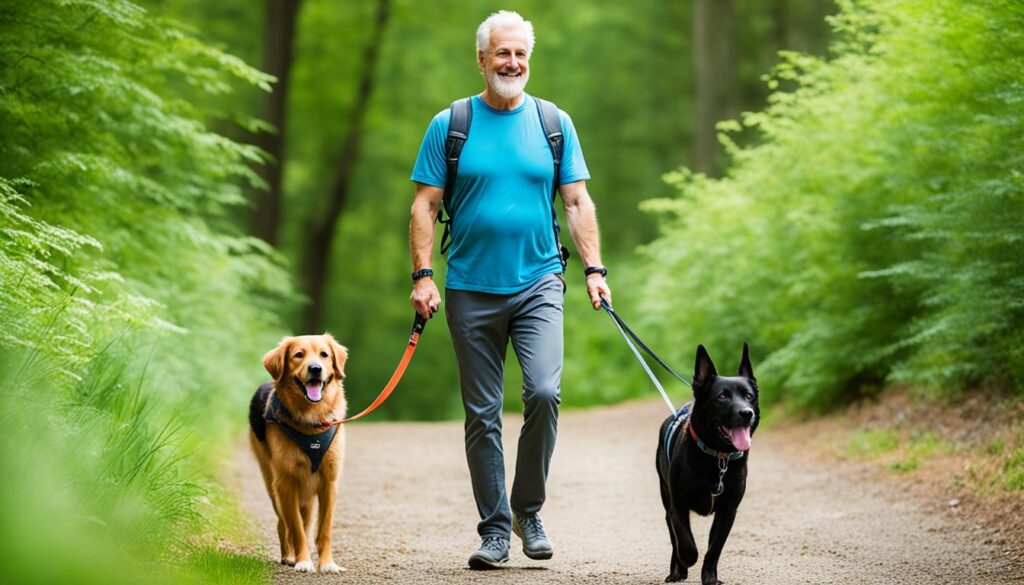
Utilizing Leashes and Collars Effectively
When embarking on a walk with a muscular canine by my side, selecting the right dog walking technique and equipment is paramount. As a professional at “All For Furry Friends,” I must ensure that I am using durable leashes and appropriate collar choices that provide control without causing discomfort to the dog. Here, I delve into the various options available and how each can either enhance or hinder our walking experience.
The Pros and Cons of Different Types of Leashes
The leash is the crucial point of contact between a dog walker and their canine companion, and its make and design are vital factors to consider for anyone handling a strong animal. Highly durable leashes are a must when it comes to the safety and enjoyment of the walk for both parties.
| Leash Type | Pros | Cons |
|---|---|---|
| Standard Flat Leash | Provides good control, and durability if the material is thick enough | Limited maneuverability; may not have enough ‘give’ for larger dogs |
| Double-Ended Leash | Allows for attachment to both harness and collar, distributing control | Can be complicated for new users and requires a compatible harness |
| Adjustable Leash | Various length settings offer flexibility in different environments | Mechanisms can be a failure point under the force of a strong dog |
In my experience, a leash with a width of at least 1″ offers that perfect balance of durability and comfort, making it easier to manage a strong dog without worrying about the leash snapping or causing harm to my hands.
How Collar Choices Can Impact Control
A well-chosen collar is as significant as the leash in dog walking technique, acting as a critical control point and a means of communication with the dog. Here’s a comparison of how different types of collars can impact control of a strong dog:
| Collar Type | Impact on Control | Safety and Comfort |
|---|---|---|
| Flat Collar | Good for trained dogs that do not pull or for light steering | Generally safe, but may strain neck of pullers |
| Martingale Collar | Prevents escape and allows for slight corrections | Safe as long as properly fitted, and can protect throat |
| Head Halter | Provides significant control over the dog’s direction | Must be used carefully to prevent neck injury |
Users must ensure that collars fit properly and do not exert undue pressure on the dog’s neck. In my cohort of powerful breeds, I’ve seen excellent results from collars that provide control and discourage pulling, without causing physical harm or distress. My criteria always prioritize safety, ensuring that the collar enhances our walks rather than detracting from them.
“How to Walk a Dog that is Stronger Than You”
Bringing decades of walking large dogs and managing strong dogs, my strategy has evolved into an art of finesse and understanding—the key lies in establishing clear communication and consistency. Tackling the challenges of walking a dog that possesses more muscle power than you do is a journey, and here I unfold the essence of this adventure. From the cotton-soft Mastiffs to the bounding energy of Great Danes, the experiences have imparted wisdom worth sharing.
When starting the walk, I make sure to hold the leash in a manner that offers a firm grip yet allows quick adjustments. A flexible posture helps manage sudden lunges or directional shifts. Effective body language is critical; being calm and centered communicates confidence to your four-legged partner, discouraging erratic behavior before it starts.
The daily routine we establish is a combination of respect for the canine’s instinct-driven actions and dedication to training practices that encourage good manners. For example, we implement a series of cues:
- Commence the walk with a calm assertive energy aimed at reinforcing focus.
- Utilize regular verbal cues paired with treats to establish desired walking behaviors.
- Practice immediate stops to curb pulling, resuming the walk only once my dog has refocused its attention on me.
These practices not only assure safety during the walk but cultivate a bond, strengthening the loyalty that comes from mutual respect. The right technique transforms the challenge of walking strong dogs into an opportunity for bonding and behavioral triumph.
Laying the foundation through training is next. Dogs, especially strong ones, thrive on consistency to understand what is expected from them. To encourage loose-leash walking, I rely on a sensation of the leash’s slight tension to indicate to the dog that it is within the boundary of our walking harmony. A gentle pull back, followed by an immediate release once the dog yields, forms a dance of push and pull that, with patience, turns into a synchronized stride.
Managing strong dogs is not a quest for the faint of heart—it’s for those willing to invest time in crafting an understanding with their canine companion. As we continue our walks, we’re aiming for that silent conversation between us, where a gentle nudge becomes a comprehensive language of well-mannered exploration.
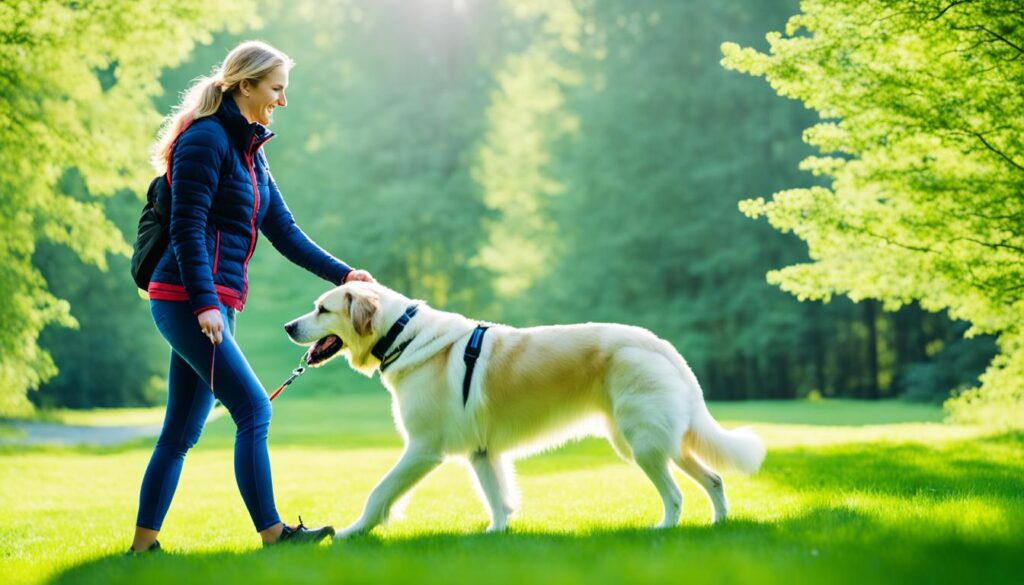
Walking Techniques for Handling Larger Canines
Walking a dog that is stronger than you demands a certain level of expertise in dog walking safety, particularly when it comes to managing strong dogs. It’s not merely about physical strength but also the know-how and preparation that makes walking such powerful companions a wonderful experience. One must develop and stick to techniques that work best for both the walker and the dog.
Body Positioning While Walking
Maintaining proper body positioning is essential when walking larger canines. My posture is always upright, with shoulders back, ensuring a firm yet gentle grip on the leash. This stance is crucial, as it provides balance, control, and signals confidence to the dog. Dogs are adept at reading body language and respond positively to a handler who exhibits a calm and assertive demeanor.
Preventing the Urge to Pull: Walking Tactics
With years of experience under my belt, I have developed key tactics to prevent dogs from pulling on the leash—a common challenge with strong dogs. One effective strategy is varying the walking path; by changing directions frequently and unpredictably, the dog’s attention remains on me, reducing their tendency to pull. Rewarding calm behavior is another technique that reinforces good walking practices.
Using verbal cues further aids in managing a dog’s strength. Simple commands like “slow,” “stop,” or “easy” help in maintaining the dog’s focus and controlling their pace. Over time, these cues become engrained, and dogs begin to walk seamlessly without presenting the urge to pull, enhancing the dog walking safety for everyone involved.

In conclusion, walking larger canines is a practice that necessitates patience, correct body alignment, and effective walking tactics to prevent unwanted pulling. By employing these methods, I ensure a safe, enjoyable walk for both myself and the dogs, embodying the ultimate goal of responsible and pleasurable dog ownership.
Dealing with Distractions and Unexpected Situations
When it comes to dog walking safety, particularly for those of us managing strong dogs, distractions are an inevitable part of the landscape. Being prepared for moments when a rabbit darts across the path or another dog appears is crucial. Effective tactics for training against distractions help ensure a safe and enjoyable walk, while also mitigating potential hazards that may arise from your dog’s reactions.
Training Your Dog to Ignore Distractions
My approach to training against distractions starts with creating a foundation of focus and obedience. I gradually introduce distractions at a distance, rewarding my dog for maintaining attention on me. Over time, I lessen the space between us and the distraction, increasing the difficulty as we progress. I incorporate cues such as “leave it,” which not only serve to direct my dog’s attention away from the distraction but also act as a critical communication tool to reinforce good behavior on walks.

Immediate Steps to Take When Encountering Sudden Distractions
Despite the best-laid training plans, sometimes distractions pop up without warning. In these situations, I’ve learned to swiftly redirect my dog’s attention back to me. If my dog begins to turn towards the trigger, I’ll initiate an abrupt change in direction, or have them sit while focusing their gaze on me until the distraction passes. Quick, calm actions like these are essential to uphold dog walking safety, ensuring both the dog’s and the walker’s well-being.
Practical Tips for Daily Walks with Your Strong Dog
When you’re puzzled over how to walk a dog that is stronger than you, it’s essential to have a sturdy repertoire of practical walking tips that can take the strain off your daily strolls. I begin with familiar surroundings, to encourage a sense of security and stability for my robust companion. Familiarity tends to reduce a dog’s urge to pull and explore erratically, allowing for a more controlled experience from the get-go.
High-value treats, which for my furry friends often means bits of boiled chicken or cheese, are indispensable tools for command reinforcement and focus redirection. A treat held at my side can maintain my dog’s attention even amidst the thrilling distractions of the outdoors, such as birds, other dogs, or the occasional neighborhood cat.
Let’s not forget about the importance of your own behavior during the walk. By incorporating circles and unexpected changes in direction, I keep my strong dog engaged and alert to my movements. This unpredictability can combat the monotony of a straight path and reduce the impulse to pull for excitement or exploration purposes.
And if I’m walking more than one dog at a time—though I generally recommend dealing with one-on-one sessions for stronger breeds—it’s crucial to stagger their walking schedules. This allows me to give each canine my undivided attention for their safety and to ensure proper control.
Here’s a simple guide to help make walks with your powerful pooch both manageable and enjoyable:
- Start by walking in a well-known environment to both you and your dog.
- Use high-value treats to reward good behavior and maintain your dog’s focus on you.
- Incorporate circles and changes in direction during the walk to keep your strong dog attentive and responsive.
- Whenever possible, walk one dog at a time for better control and individualized attention.
While these steps sound straightforward, consistent application transforms them into deeply ingrained habits. This not only reinforces each walk’s smooth execution but also forms a closer bond between me and these powerful animals entrusted to my care.
The table below offers a breakdown of actions and the benefits they bring during your walks with a stronger dog:
| Action | Benefit |
|---|---|
| Start in familiar environments | Reduces the dog’s impulse to pull and explore |
| Use high-value treats | Keeps the dog focused on you and responsive to commands |
| Incorporate changes in direction | Mitigates boredom and maintains the dog’s attention on the handler |
| Walk one dog at a time | Ensures full control and the ability to address the needs of each individual dog |
Maintaining Safety and Enjoying the Walk
Achieving dog walking safety while also enjoying walks with your dog involves a delicate balance. As a professional dog walker, my focus always remains on ensuring the safety of both the dog and myself. Let’s unpack how we can maintain this balance effectively, aligning with our goals for a safe and joyful walk.
How To Keep Both You and Your Dog Safe
Sturdy equipment tailored to the size and strength of your dog is critical. I opt for robust leashes and harnesses that can handle their energy without breaking or causing harm. Awareness of our surroundings is also key; I stay vigilant, watching for potential triggers that might cause excitement or fear in the dogs I walk. And when it comes to distractions, calmness is my mantra. Whether it’s a squirrel sprinting across the path or another dog’s bark, responding calmly and confidently keeps both of us safe and collected.
Making the Walk Enjoyable for You and Your Dog
The true joy in walks comes from seeing my canine companions revel in their surroundings while feeling secure in their explorations. To this end, I structure our walks to include controlled freedom. This balance allows dogs the opportunity to investigate interesting smells and sights while still under guidance. Regular breaks for play or a simple ‘sit and watch’ moment go a long way in enhancing our walk experience.
Ultimately, the walks are a time for us to connect, with safety at the forefront and enjoyment naturally following suit. Each walk is a step further in building a bond and an understanding, aligning the necessity of dog walking safety with the simple pleasures that come from enjoying walks with your dog.
Conclusion
In the journey of mastering the art of walking large dogs safely, the primary elements boil down to controlling powerful dogs with confidence and care. Ensuring an enjoyable and secure walk is not as challenging as it might appear. Equipped with the right gear, engaging in consistent training, and understanding the unique behaviors and needs of your dog are quintessential components. Indeed, walking by your side should evoke a sense of pride and pleasure in every step taken together.
My experiences with “All For Furry Friends” have reinforced the importance of patience and perseverance in teaching loose-leash walking. It’s about crafting a dance between guidance and freedom—a dance that asks for a strong lead yet offers room for expression. These practices have been fundamental in empowering myself and other dog owners to navigate the streets with our stronger dogs by our sides, creating a harmonious rhythm to our daily strolls.
To conclude, the essence of controlling powerful dogs lies not only in physical strength but also in mental tact and emotional connection. As a dedicated professional dog walker on the beautiful Gold Coast, I’ve embraced the challenges and triumphs of walking large dogs safely. With an ever-evolving toolkit of techniques and a heartfelt understanding of canine companionship, every walk is a testament to the trust and respect forged between man and beast.
FAQ
What techniques can I use for walking a dog stronger than me?
Utilize a front-clip harness to redirect your dog’s pulling, practice consistent loose-leash walking techniques, and maintain proper body positioning. Also, be prepared to change direction frequently and reward your dog for calm behavior to prevent pulling.
How can understanding my dog’s body language improve our walk?
Recognizing signs of excitement or stress in your dog can help you manage their behavior on walks. This knowledge allows you to adjust your approach and use techniques to calm them down or redirect their focus.
Why do dogs pull on the leash?
Dogs may pull on the leash due to natural instincts to explore, excitement, excess energy, or even as a response to seeing other animals or people. Proper training can help mitigate this behavior.
What should I consider when selecting gear for a strong dog?
Choose sturdy, durable equipment like a strong leash and a well-fitting front-clip harness. Ensure the gear is appropriate for your dog’s size and strength while providing comfort and safety.
Why is consistent training important for walking strong dogs?
Consistent training establishes clear expectations and helps your dog learn to walk nicely beside you. It also reinforces positive behavior, which is crucial for controlling a strong dog on a leash.
What are the benefits and drawbacks of different leashes?
Durable leashes are necessary for strong dogs, with thick width and strong material being benefits. However, heavier leashes can be cumbersome and difficult to handle. Balance between strength and manageability is key.
How should I hold the leash when walking a large dog?
Keep your shoulders back, and grip the leash firmly yet comfortably. Allow some slack in the leash but be ready to tighten your hold if the dog begins to pull or gets distracted.
What immediate actions should I take if we encounter a distraction?
If you encounter a sudden distraction, redirect your dog’s attention, stop, or change direction. This can help maintain control and prevent your dog from pulling towards the distraction.
How can I address my dog’s physical exercise needs to improve our walks?
Ensure your dog gets adequate physical exercise and mental stimulation before walks. A dog that has expended excess energy is less likely to pull and will be more manageable on a walk.
How can I ensure the safety of both myself and my dog during walks?
Use sturdy equipment, stay aware of your surroundings, and confidently handle distractions. Also, keep your dog’s potential reactions in mind and be prepared to manage them calmly.
Can you suggest practical tips for my daily walks with a strong dog?
Start walks in familiar areas, use high-value treats to maintain focus, and include circles and direction changes to keep your dog engaged. Consider walking one dog at a time for better control.
How can I make walks enjoyable for both my dog and myself?
Strike a balance between control and freedom. Allow your dog moments to explore and sniff but keep the walk structured. Use treats and praise to make the experience rewarding and pleasant.
